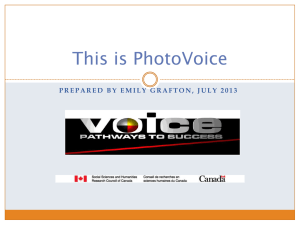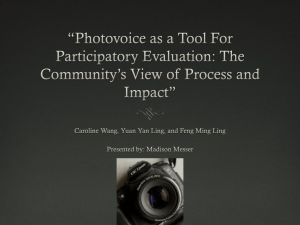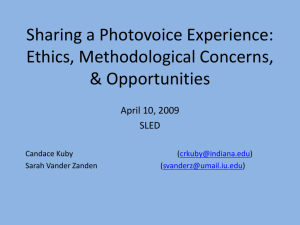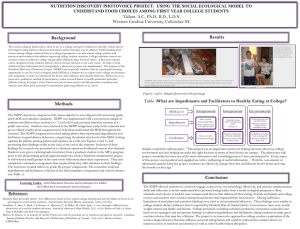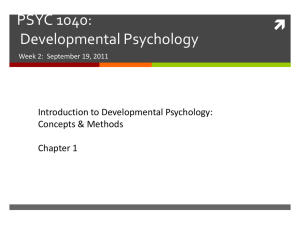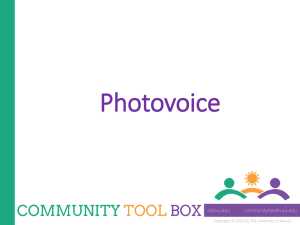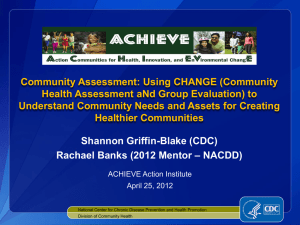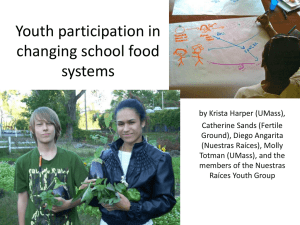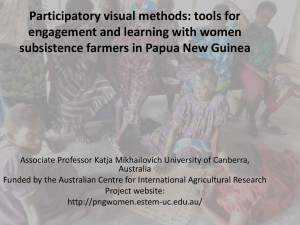Using a Photovoice Class Project to Meet Commission on
advertisement
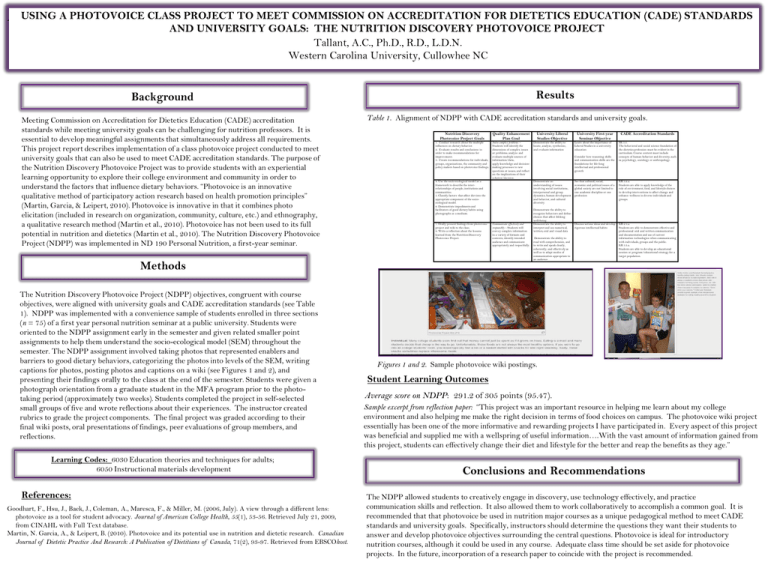
. USING A PHOTOVOICE CLASS PROJECT TO MEET COMMISSION ON ACCREDITATION FOR DIETETICS EDUCATION (CADE) STANDARDS AND UNIVERSITY GOALS: THE NUTRITION DISCOVERY PHOTOVOICE PROJECT Tallant, A.C., Ph.D., R.D., L.D.N. Western Carolina University, Cullowhee NC Results Background Meeting Commission on Accreditation for Dietetics Education (CADE) accreditation standards while meeting university goals can be challenging for nutrition professors. It is essential to develop meaningful assignments that simultaneously address all requirements. This project report describes implementation of a class photovoice project conducted to meet university goals that can also be used to meet CADE accreditation standards. The purpose of the Nutrition Discovery Photovoice Project was to provide students with an experiential learning opportunity to explore their college environment and community in order to understand the factors that influence dietary behaviors. “Photovoice is an innovative qualitative method of participatory action research based on health promotion principles” (Martin, Garcia, & Leipert, 2010). Photovoice is innovative in that it combines photo elicitation (included in research on organization, community, culture, etc.) and ethnography, a qualitative research method (Martin et al., 2010). Photovoice has not been used to its full potential in nutrition and dietetics (Martin et al., 2010). The Nutrition Discovery Photovoice Project (NDPP) was implemented in ND 190 Personal Nutrition, a first-year seminar. Table 1. Alignment of NDPP with CADE accreditation standards and university goals. Nutrition Discovery Photovoice Project Goals Quality Enhancement Plan Goal 1. Conduct research about the multiple influences on dietary behavior. 2. Evaluate results and conclusions in order to make recommendations for improvement. 3. Create recommendations for individuals, groups, organizations, the community and policy makers based on photovoice findings. Solve complex problems – Students will identify the dimensions of complex issues or problems; analyze and evaluate multiple sources of information/data; apply knowledge and decisionmaking processes to new questions or issues; and reflect on the implications of their solution/decision. 4. Use the socio-ecological model as a framework to describe the interrelationships of people, institutions and communities. 5. Classify factors that affect diet into the appropriate component of the socioecological model. 6. Demonstrate impediments and facilitators of good dietary habits using photographs as a medium. 7. Orally present findings from photovoice project and wiki to the class. 8. Write a reflection about the lessons learned from the Nutrition Discovery Photovoice Project. Methods The Nutrition Discovery Photovoice Project (NDPP) objectives, congruent with course objectives, were aligned with university goals and CADE accreditation standards (see Table 1). NDPP was implemented with a convenience sample of students enrolled in three sections (n = 75) of a first year personal nutrition seminar at a public university. Students were oriented to the NDPP assignment early in the semester and given related smaller point assignments to help them understand the socio-ecological model (SEM) throughout the semester. The NDPP assignment involved taking photos that represented enablers and barriers to good dietary behaviors, categorizing the photos into levels of the SEM, writing captions for photos, posting photos and captions on a wiki (see Figures 1 and 2), and presenting their findings orally to the class at the end of the semester. Students were given a photograph orientation from a graduate student in the MFA program prior to the phototaking period (approximately two weeks). Students completed the project in self-selected small groups of five and wrote reflections about their experiences. The instructor created rubrics to grade the project components. The final project was graded according to their final wiki posts, oral presentations of findings, peer evaluations of group members, and reflections. Learning Codes: 6030 Education theories and techniques for adults; 6050 Instructional materials development References: Goodhart, F., Hsu, J., Baek, J., Coleman, A., Maresca, F., & Miller, M. (2006, July). A view through a different lens: photovoice as a tool for student advocacy. Journal of American College Health, 55(1), 53-56. Retrieved July 21, 2009, from CINAHL with Full Text database. Martin, N. Garcia, A., & Leipert, B. (2010). Photovoice and its potential use in nutrition and dietetic research. Canadian Journal of Dietetic Practice And Research: A Publication of Dietitians of Canada, 71(2), 93-97. Retrieved from EBSCOhost. University Liberal Studies Objective Demonstrate the ability to locate, analyze, synthesize, and evaluate information Consider how reasoning skills and communication skills are the foundations for life-long intellectual and professional growth Demonstrate an understanding of issues involving social institutions, interpersonal and group dynamics, human development and behavior, and cultural diversity Communicate effectively and responsibly – Students will convey complex information in a variety of formats and contexts; identify intended audience and communicate appropriately and respectfully. University First-year Seminar Objective Learn about the importance of Liberal Studies in a university education Demonstrate the ability to recognize behaviors and define choices that affect lifelong well-being Demonstrate the ability to interpret and use numerical, written, oral and visual data Demonstrate the ability to read with comprehension, and to write and speak clearly, coherently, and effectively as well as to adapt modes of communication appropriate to an audience CADE Accreditation Standards SK 5.3. The behavioral and social science foundation of the dietetics profession must be evident in the curriculum. Course content must include concepts of human behavior and diversity, such as psychology, sociology or anthropology. See that cultural, social, economic and political issues of a global society are not limited to one academic discipline or one profession KR 3.2.a. Students are able to apply knowledge of the role of environment, food, and lifestyle choices to develop interventions to affect change and enhance wellness in diverse individuals and groups. Discuss serious ideas and develop rigorous intellectual habits KR 2.1.a. Students are able to demonstrate effective and professional oral and written communication and documentation and use of current information technologies when communicating with individuals, groups and the public. KR 3.3.a. Students are able to develop an educational session or program/educational strategy for a target population. Figures 1 and 2. Sample photovoice wiki postings. Student Learning Outcomes Average score on NDPP: 291.2 of 305 points (95.47). Sample excerpt from reflection paper: “This project was an important resource in helping me learn about my college environment and also helping me make the right decision in terms of food choices on campus. The photovoice wiki project essentially has been one of the more informative and rewarding projects I have participated in. Every aspect of this project was beneficial and supplied me with a wellspring of useful information….With the vast amount of information gained from this project, students can effectively change their diet and lifestyle for the better and reap the benefits as they age.” Conclusions and Recommendations The NDPP allowed students to creatively engage in discovery, use technology effectively, and practice communication skills and reflection. It also allowed them to work collaboratively to accomplish a common goal. It is recommended that that photovoice be used in nutrition major courses as a unique pedagogical method to meet CADE standards and university goals. Specifically, instructors should determine the questions they want their students to answer and develop photovoice objectives surrounding the central questions. Photovoice is ideal for introductory nutrition courses, although it could be used in any course. Adequate class time should be set aside for photovoice projects. In the future, incorporation of a research paper to coincide with the project is recommended.
